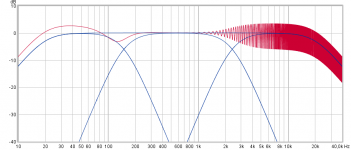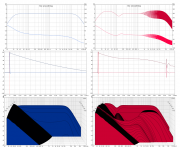DF96.Maybe they are not lying; maybe they are merely ignorant or confused. You choose whichever explanation you prefer for the nonsense quoted above.
I agree that it isnt very clearly stated.
I comes across as technobable doesnt it.
At its heart though I think the idea that the idea of a loudspeaker delivering sounds that are delayed by different amounts according to their frequency has plausibility...would you agree ?
That looks the same. This is from the chip datasheet
"The input signal is separated into three regions : bass (20Hz to 150Hz), middle (150Hz to 2.4kHz) and treble (2.4kHz to 20kHz). These regions are then joined again with the middle and treble regions phase shifted -180 and -360 respectively with respect to the bass signal. This phase shift adjusts the delay time characteristic for each band and minimizes the distortion of the rising section of the audio signal."
Thanks look it up 🙂 really don't know if simulation is the reality but had a try with system stop bands as BW2 roll off at 20Hz-20kHz, slopes for pass bands are LR4, middle band advanced 3,33mS (1/2 cycle 150Hz) relative to bass and treble band advanced 6,66mS (1/1 cycle 150Hz) relative to bass, summing the three as a wet effect and mix it fifty fifty with a dry signal (20hz-20kHz band pass):
Dry verse wet effect mixed fifty fifty with dry:
Can share effect as impulse response wav-file if any one like to load filter into a players convolution engine.
Attachments
Last edited:
It assumes a lot of ignorance and gullibility, for a start, the speed of sound in air is a constantIll agree that the way its expressed it assumes a lot of knowledge
Thanks for the offer, I only have a crummy chromebook so I don't think I could do it to load into my DCX2496, but I presume I could do it directly? I'm not very computer savvy and I haven't had the DSP for long.....Can share effect as impulse response wav-file if any one like to load filter into a players convolution engine.
Yes but its not the transmission of sound through air that BBE corrects for.It assumes a lot of ignorance and gullibility, for a start, the speed of sound in air is a constant
It is the impedance of the speaker that varies with frequency. .. can you follow the implications of that wrt delay of electrocal signal at the voice coil.
Do you understand how this "When we hear sound unamplified, we receive the higher harmonics first and fundamental sound behind them" is saying higher frequencies travel faster than lower ones?
I'm afraid to say I'm finding it increasingly hard to believe that you can get so many things so wrong unintentionallyIt is the impedance of the speaker that varies with frequency. .. can you follow the implications of that wrt delay of electrocal signal at the voice coil.
Enlighten me then.. and whats with the 'so many things' Scott. Stop being aggresive.I'm afraid to say I'm finding it increasingly hard to believe that you can get so many things so wrong unintentionally
For one thing speed does depend on frequency but only slightly. In an ideal gas the speed is not related to frequency but theyre not ideal gasses are they.
Who is Poe ?Poe's law in action?
And wavelength, however, the product is a constant, that is, the speed of sound.For one thing speed does depend on frequency but only slightly.
Hmmm, who's being aggressive?Stop being aggresive.
Enlighten me then..
I read that as a challenge, not a serious request. I see no evidence of your desire for "enlightenment"
But the point is that the speed of sound does vary with frequency but only slightly.And wavelength, however, the product is a constant, that is, the speed of sound.
Hmmm, who's being aggressive?
You could also read and try to understand the help and guidance you have been given by many here. Regarding the speed of sound, it can vary very slightly due to frequency in the ultrasonic, hardly relevant
So lets see... what you are saying is that bbe is all hogwash and that all the manufacturers who have incorporated this in thwir products from jvc to sanyo to alpine and scores more are all misled and have been pedling a function that does not do as its makers say. Is that right ?
As has already been said many times, it effects the sound, you and many others may like it, there is nothing wrong with that, what I object to is false statements like the one I quoted.
 @armarra1 - Please do not check the "quote message in the reply" box if the post is right above yours.
@armarra1 - Please do not check the "quote message in the reply" box if the post is right above yours.So lets see... what you are saying is that bbe is all hogwash and that all the manufacturers who have incorporated this in thwir products from jvc to sanyo to alpine and scores more are all misled and have been pedling a function that does not do as its makers say. Is that right ?
OK, let's look at what is said
From JVC - BBE
Lo Contour - restores the detail and warmth to low frequencies
BBE Process - restores clarity and definition to high frequencies
iSet - Adjusts center frequencies to your find mid-range "sweet spot"
Sound Field - expands the sonic depth and presence of your audio
Mach3 Bass - "bumps" low frequencies for more thump
Mach3 Gain - "bumps" the low gain for more punch
This is available for the high quality products listed here JVC - BBE
I think we can safely say that this is NOT high fidelity.
So it 'effects' the sound but apparently it does so without any concern for restoring realism. In that same vein you could say stereo and dolby affect the sound. Both dolby and bbe are compensating for inadequacies in the recording and playback process.As has already been said many times, it effects the sound, you and many others may like it, there is nothing wrong with that, what I object to is false statements like the one I quoted.
It is in fact the sending of sound through a speaker that causes different delays in the originatiin of the frequencies.
If they are originated at different times from the speaker cone due to the way the voice coil responds to differing frequencies then the sounds will indeed be altered from the ones that instead come straight from the instuments and performers themselves.
The response of the voice coil of a speaker does differ with frequency and that sends the sounds off towards the listener at different times.
Its nothing to do with the sounds travelling faster its to do with the delay vefore they emanate from the speaker.
Is that any clearer ?
What you can say... is that the descriptions are all very positive. Whether they are high fidelity or not cannot be conveyed very well in words now can it.OK, let's look at what is said
From JVC - BBE
Lo Contour - restores the detail and warmth to low frequencies
BBE Process - restores clarity and definition to high frequencies
iSet - Adjusts center frequencies to your find mid-range "sweet spot"
Sound Field - expands the sonic depth and presence of your audio
Mach3 Bass - "bumps" low frequencies for more thump
Mach3 Gain - "bumps" the low gain for more punch
This is available for the high quality products listed here JVC - BBE
I think we can safely say that this is NOT high fidelity.
It's mostly due to phase shifts in the crossover region between drivers, it's nothing to do with the driver's impedance only in as much as this impinges on the crossover. It is usually corrected in the speaker buy crossover manipulation or physical time alignment of the drivers or both. Nowadays with many active systems, this manipulation is done at line level. I suggest you research crossovers and transient response
- Home
- General Interest
- Everything Else
- Music Reproduction Systems - what are we trying to achieve?

